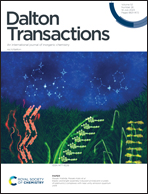Modulation of iron spin states in highly distorted iron(iii) porphyrins: H-bonding interactions and implications in hemoproteins†
Abstract
A family of five- and six-coordinated Fe-porphyrins which enable us to scrutinize the effects of non-covalent interactions on the out-of-plane displacement of iron and its spin-states and axial ligand orientation in a single distorted macrocyclic environment has been reported. Combined analysis using single-crystal X-ray structure determination and EPR spectral investigation revealed the stabilization of the high-spin state of iron in the five-coordinate complex FeIII(TPPBr8)(OCHMe2), while six-coordinate complexes [FeIII(TPPBr8)(MeOH)2]ClO4, [FeIII(TPPBr8)(H2O)2]ClO4 and [FeIII(TPPBr8)(1-MeIm)2]ClO4 stabilize admixed-high, admixed-intermediate and low-spin states, respectively. The H-bonding interactions between the weak axial H2O/MeOH and perchlorate anion resulted in an elongation of the Fe–O bond which eventually shortened the Fe–N(por) distances leading to the stabilization of the admixed spin state of iron which, otherwise, stabilizes the high-spin (S = 5/2) state only. In addition, the iron atom in [FeIII(TPPBr8)(H2O)2]ClO4 is displaced by 0.02 Å towards one of the water molecules engaged in the H-bonding interactions leading to two different Fe–O (H2O) distances of 2.098(8) and 2.122(9) Å. In contrast, iron in [FeIII(TPPBr8)(MeOH)2]ClO4 sits on the plane of the porphyrin since both the axial methanol units are engaged in similar H-bonding interactions with the ClO4− ion. Moreover, the X-ray structure of low-spin FeII(TPPBr8)(1-MeIm)2 revealed a dihedral angle of 63.0° between two imidazoles which deviates largely from the expected angle of 90° (perpendicular orientations) since the axial imidazole protons are engaged in strong intermolecular C–H⋯π interactions which thereby restrict the axial ligand movement. The complex also displays the shortest Fe–N(1-MeIm) bond along with smallest dihedral angles of 7.8° and 22.4° between the axial imidazole ring and the closest Fe–Np axis due to strong π-interactions between iron and the axial imidazole ligand. Our work highlights the influence of non-covalent interactions on the out-of-plane displacement and spin state of iron and axial ligand orientations which are indeed important steps in the functioning of various hemoproteins.



 Please wait while we load your content...
Please wait while we load your content...